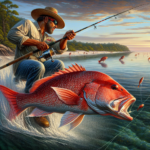Yellowfin Tuna Fishing in the Gulf of Mexico

Introduction
Did you know that the Gulf of Mexico is home to some of the most sought-after Yellowfin Tuna fishing spots in the world? This article will delve into the intricacies of Yellowfin Tuna fishing in the Gulf of Mexico, covering everything from the best fishing techniques and gear to the top fishing spots and seasonal considerations. Whether you’re a seasoned angler or a novice looking to try your hand at catching this prized species, this guide will provide you with all the information you need to succeed.
Yellowfin Tuna fishing in the Gulf of Mexico is not just a pastime; it’s a thrilling adventure that offers both challenges and rewards. Understanding the best techniques, knowing where to fish, and being aware of the seasonal variations can significantly enhance your fishing experience. This article aims to equip you with the knowledge and tools necessary to make your next fishing trip a memorable one.
Background/Context
Historical or Cultural Significance
Yellowfin Tuna, also known as Thunnus albacares, have been a significant part of the Gulf of Mexico’s fishing culture for decades. Historically, these fish have been a staple for both commercial and recreational fishermen. The Gulf’s rich marine ecosystem provides an ideal habitat for Yellowfin Tuna, making it a prime location for anglers from around the world.
Geographical Overview
The Gulf of Mexico is a large ocean basin bordered by the United States, Mexico, and Cuba. It covers an area of approximately 600,000 square miles and features a diverse range of marine habitats, from shallow coastal waters to deep offshore areas. The Gulf’s warm climate and nutrient-rich waters create an ideal environment for a variety of fish species, including Yellowfin Tuna.
Key Points/Details
Fishing Techniques
Technique Overview
Several fishing techniques are effective for catching Yellowfin Tuna in the Gulf of Mexico. These include trolling, chunking, and live bait fishing. Each method has its own set of advantages and is suited to different conditions and locations.
When and Where to Use
Trolling: This technique involves dragging lures or bait behind a moving boat. It’s particularly effective in open waters where Yellowfin Tuna are known to roam.
Chunking: This method involves cutting bait into small pieces and throwing them into the water to attract tuna. It’s best used when fishing in deeper waters or near oil rigs where tuna are likely to congregate.
Live Bait Fishing: Using live bait such as small fish or squid can be highly effective, especially when fishing near structures like reefs or oil rigs.
Recommended Gear
- Rods: Heavy-duty rods capable of handling large fish.
- Reels: High-capacity reels with strong drag systems.
- Lines: Braided lines with a high breaking strength.
- Bait/Lures: Live bait, trolling lures, and chunk bait.
Species Information
Species Overview
Yellowfin Tuna are known for their speed and strength, making them a challenging catch. They are typically found in warm, deep waters and are known to migrate seasonally. These fish can grow up to 400 pounds, although the average catch in the Gulf of Mexico is usually between 50 and 150 pounds.
Best Practices
To successfully catch Yellowfin Tuna, it’s essential to use the right techniques and gear. Trolling at high speeds with brightly colored lures can attract these fast-moving fish. When chunking, use fresh bait and be patient, as it can take time to attract tuna. Live bait fishing near structures can also be highly effective, especially during the early morning or late afternoon when tuna are most active.
Location Information
Top Fishing Spots
- Venice, Louisiana: Known as the “Tuna Capital of the World,” Venice offers some of the best Yellowfin Tuna fishing in the Gulf.
- Destin, Florida: This area is famous for its deep-sea fishing opportunities and is a great spot for catching Yellowfin Tuna.
- Port Aransas, Texas: Another excellent location, especially during the summer months when tuna are more abundant.
Regulations and Licenses
Fishing regulations in the Gulf of Mexico can vary by state, so it’s essential to check local guidelines before heading out. Generally, anglers will need a fishing license, and there may be specific catch limits and seasonal restrictions for Yellowfin Tuna. Always adhere to these regulations to ensure sustainable fishing practices.
Seasonal Considerations
Seasonal Variations
Yellowfin Tuna fishing in the Gulf of Mexico is influenced by seasonal changes. The best time to fish for Yellowfin Tuna is typically from late spring to early fall when water temperatures are warmer. During the winter months, tuna may migrate to different areas, making them harder to find.
Best Times to Fish
The optimal times for Yellowfin Tuna fishing are early morning and late afternoon. These periods coincide with the tuna’s feeding times, increasing your chances of a successful catch. Additionally, fishing during a full moon can be advantageous as it affects the fish’s feeding behavior.
Events and Tournaments
Event Overview
The Gulf of Mexico hosts several fishing tournaments throughout the year, many of which include categories for Yellowfin Tuna. Notable events include the Louisiana Gulf Coast Billfish Classic and the Destin Fishing Rodeo.
Preparation Tips
To prepare for a fishing tournament, ensure your gear is in top condition and practice your techniques. Familiarize yourself with the tournament rules and regulations, and consider pre-fishing the area to identify the best spots. Staying hydrated and well-rested is also crucial for peak performance during the event.
Tips and Best Practices
General Tips
- Always use fresh bait to increase your chances of attracting Yellowfin Tuna.
- Pay attention to water temperature and currents, as these can affect tuna behavior.
- Be patient and persistent; Yellowfin Tuna can be elusive, but persistence pays off.
Avoid Common Mistakes
- Using the wrong gear: Ensure your rods, reels, and lines are suitable for large, powerful fish.
- Ignoring local regulations: Always check and adhere to local fishing regulations to avoid fines and contribute to conservation efforts.
- Fishing at the wrong time: Focus on early morning and late afternoon when tuna are most active.
Advanced Techniques
- Kite Fishing: This technique involves using a kite to suspend bait on the water’s surface, making it more enticing to tuna.
- Chumming: Create a chum slick by continuously throwing small pieces of bait into the water to attract tuna.
- Using Electronics: Utilize fish finders and sonar to locate schools of Yellowfin Tuna more effectively.
Gear and Equipment Recommendations
Essential Gear
- Heavy-duty fishing rods
- High-capacity reels with strong drag systems
- Braided fishing lines
- Live bait, trolling lures, and chunk bait
Optional Gear/Upgrades
- Fish finders and sonar equipment
- Kite fishing gear
- High-quality fishing gloves
Where to Buy or Rent
Local fishing shops in coastal towns like Venice, Destin, and Port Aransas offer a wide range of gear for purchase or rent. Online stores such as Bass Pro Shops and Cabela’s also provide extensive selections of fishing equipment suitable for Yellowfin Tuna fishing.
Safety and Conservation
Safety Tips
- Always check the weather forecast before heading out to sea.
- Wear a life jacket and ensure all safety equipment on your boat is in good condition.
- Stay hydrated and protect yourself from the sun with appropriate clothing and sunscreen.
Conservation Practices
- Practice catch and release to help maintain tuna populations.
- Respect local wildlife and avoid disturbing marine habitats.
- Follow all fishing regulations and guidelines to promote sustainable fishing practices.
Planning Your Trip
Accommodations
There are numerous accommodation options near popular fishing spots in the Gulf of Mexico. In Venice, Louisiana, you can find fishing lodges and hotels catering to anglers. Destin, Florida, offers a range of beachfront resorts and vacation rentals, while Port Aransas, Texas, has several hotels and motels close to the marina.
Travel Tips
- Plan your route in advance and consider the best times to travel to avoid traffic.
- If you’re flying, check airline policies on transporting fishing gear.
- Consider renting a car if you’re traveling to remote fishing spots.
Additional Activities
While in the Gulf of Mexico, take advantage of other activities such as snorkeling, scuba diving, and exploring local beaches. Many coastal towns also offer excellent dining options, shopping, and cultural attractions, making it a great destination for families and groups.
Frequently Asked Questions (FAQs)
What is the best time of year to fish for Yellowfin Tuna in the Gulf of Mexico?
The best time to fish for Yellowfin Tuna in the Gulf of Mexico is from late spring to early fall when water temperatures are warmer.
Do I need a fishing license to fish for Yellowfin Tuna in the Gulf of Mexico?
Yes, a fishing license is required, and specific regulations may vary by state. Always check local guidelines before heading out.
What type of bait is best for catching Yellowfin Tuna?
Live bait such as small fish or squid is highly effective, as well as trolling lures and chunk bait.
Are there any fishing tournaments for Yellowfin Tuna in the Gulf of Mexico?
Yes, several tournaments include categories for Yellowfin Tuna, such as the Louisiana Gulf Coast Billfish Classic and the Destin Fishing Rodeo.
Conclusion
Yellowfin Tuna fishing in the Gulf of Mexico offers an exhilarating experience for anglers of all skill levels. By understanding the best techniques, knowing where to fish, and being aware of seasonal variations, you can significantly enhance your chances of a successful catch. Remember to follow local regulations, practice conservation, and prioritize safety to ensure a rewarding and sustainable fishing adventure. So gear up, plan your trip, and get ready to embark on an unforgettable Yellowfin Tuna fishing journey in the Gulf of Mexico.




